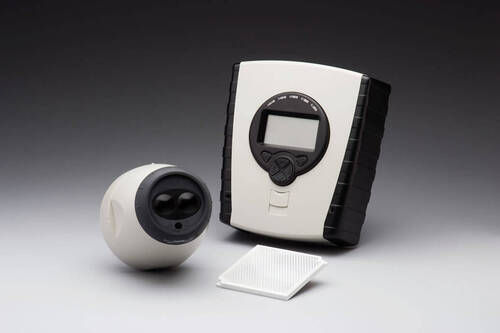Product Description
An IR (Infrared) beam detector is a type of sensor device used to detect the presence or interruption of an infrared beam. These detectors are commonly used in various applications such as security systems, automation, and industrial processes.
Here's how they typically work and where they are used:
Working Principle:
- IR beam detectors consist of two main components: an infrared emitter (transmitter) and an infrared receiver.
- The emitter emits an infrared beam of light, typically in the form of an invisible IR light source.
- The receiver, placed at a certain distance from the emitter, is designed to detect this emitted infrared light.
- When the infrared beam is unobstructed and reaches the receiver, the detector considers the beam to be "intact," and no alarm is triggered.
- If an object or person obstructs the infrared beam path between the emitter and receiver, the detector registers a break in the beam, signaling an event or alarm.
Applications:
- Security Systems: IR beam detectors are commonly used in security systems to create an invisible barrier that, when crossed, triggers an alarm or alerts security personnel. For example, they can be used to protect windows, doors, or fence lines.
- Automation: IR beam detectors are used in automation and control systems to detect the presence or position of objects on conveyor belts, assembly lines, and other industrial processes. They can be used to trigger actions such as stopping a machine or diverting a product.
- Access Control: In access control systems, IR beam detectors can be used to sense when a person or vehicle approaches a gate or barrier. They can be used to automatically open or close gates or doors.
- Photography: In photography, IR beam detectors can be used as triggers to capture fast-moving objects or wildlife. When the beam is interrupted by the subject, it triggers the camera to take a shot.
- Safety Systems: In industrial environments, IR beam detectors can be used as safety devices to ensure that a machine or equipment is not operated if there is an obstruction in its working area.
- Traffic Management: IR beam detectors are used in traffic control systems to monitor vehicle presence at intersections or toll booths. When a vehicle breaks the beam, it triggers traffic lights or toll collection.
Types:
- There are various types of IR beam detectors, including single-beam and dual-beam detectors. Dual-beam detectors are more resistant to false alarms caused by small objects or environmental conditions like rain and fog.
Considerations:
- Environmental Factors: Extreme weather conditions, such as heavy rain or fog, can affect the performance of IR beam detectors.
- Alignment: Proper alignment of the emitter and receiver is crucial for reliable operation.
- Range: The range of the IR beam should be selected based on the specific application requirements.
FAQ:
Q. What is an IR beam detector?
Ans: An IR beam detector is a sensor device that uses infrared technology to detect the presence or interruption of an infrared beam. It consists of an infrared emitter (transmitter) and an infrared receiver.
Q. How does an IR beam detector work?
Ans: An IR beam detector works by emitting an invisible infrared beam from the transmitter to the receiver. When this beam is unobstructed, no alarm is triggered. If an object or person interrupts the beam, it triggers an event or alarm.
Q. What are the common applications of IR beam detectors?
Ans: IR beam detectors are used in various applications, including security systems, automation, access control, photography, industrial safety, and traffic management.
Q. What is the difference between a single-beam and a dual-beam IR detector?
Ans: A single-beam IR detector uses one emitter and one receiver. It is suitable for applications where simplicity is essential but may be more susceptible to false alarms. A dual-beam IR detector uses two emitters and two receivers, making it more resistant to false alarms caused by small objects or environmental conditions like rain and fog.
Q. What factors can affect the performance of IR beam detectors?
Ans: Environmental factors such as heavy rain, fog, or extreme temperatures can affect IR beam detectors' performance. Proper alignment of the emitter and receiver is crucial, and the selected range should match the specific application requirements.
Q. Are IR beam detectors suitable for outdoor use?
Ans: Yes, IR beam detectors can be used outdoors, but their performance may be influenced by weather conditions. Dual-beam detectors are often preferred for outdoor applications due to their increased reliability.
Q. Can IR beam detectors be used in conjunction with other security or automation systems?
Ans: Yes, IR beam detectors can be integrated into larger security or automation systems. They can trigger alarms, activate cameras, control access gates, or stop machinery in response to detected events.
Q. Do IR beam detectors require regular maintenance?
Ans: IR beam detectors typically require minimal maintenance. However, periodic checks for alignment, cleanliness, and any obstructions in the beam path are recommended to ensure reliable operation.
Q. Are IR beam detectors pet-friendly?
Ans: Some IR beam detectors can be configured to be pet-friendly by adjusting their sensitivity settings. This prevents false alarms caused by small animals while still detecting human intruders.
Q. What is the range of IR beam detectors?
Ans: The range of IR beam detectors can vary widely, from a few feet to several hundred feet, depending on the specific model and application requirements. It's important to select a detector with an appropriate range for the intended use.
Q. Can IR beam detectors work in complete darkness?
Ans: Yes, IR beam detectors can operate in complete darkness since they rely on infrared light, which is invisible to the human eye.
